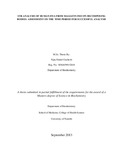| dc.description.abstract | Forensic entomology is a branch of biology involving study of insects that are present on carrion in order to facilitate identification of the body, and to determine Postmortem Interval (PMI). Its importance becomes inevitable when one comes across some incident where a corpse is unidentifiable and lots of maggots or other insects are present. Frequently, application of forensic entomology is in the use of insect maggots for identification of specimen or human remains. Maggots‟ crop analysis could be valuable in criminal investigations when maggots are found at a crime scene and a corpse is absent. If live maggots are found at a location without the corpse around, it is likely that a corpse has been moved from the crime scene. If there is a different food source near the scène, maggots may move away from the corpse to the new food source. Human short tandem repeat (STR) profile from this study was used to support the association of maggots to a specific corpse. The aim of this research was to assess the time period for successful STR analyses of human DNA from the contents of crop of third instar maggots (Protophormia terraenovae) obtained from decomposing human corpses and investigate the human DNA turnover and degradation in the maggots crop after they are removed from food and/or are fed on a new/different food source. Maggots were collected from human corpse after a specific post-mortem interval. Some maggots were starved while others were fed on beef. Ten maggots were used in each case. The maggot crops were removed and DNA extracted from the reference sample and gut contents. Human DNA was quantified using real time PCR prior to amplification and STRs profiling at 16 human genetic loci. Results showed that amount of human DNA recovered from the maggots decreased with time. For maggots fed on beef, the human DNA could only be recovered up to day two. Since the starved maggots did not have any other food source after they were collected from the corpse the human DNA could only be recovered up to day four. STR analyses of DNA from maggots‟ crop content generated profiles that matched that of reference samples although some of the alleles were not amplifiable therefore generating partial profiles. This may be due to nucleases‟ activity present in the gut of the larvae which may have caused degradation of DNA and consequently reduction in DNA yield. Results of this study will help forensic analysts in determining the window of time during which maggots are useful in criminal investigations involving death of humans. | en_US |

